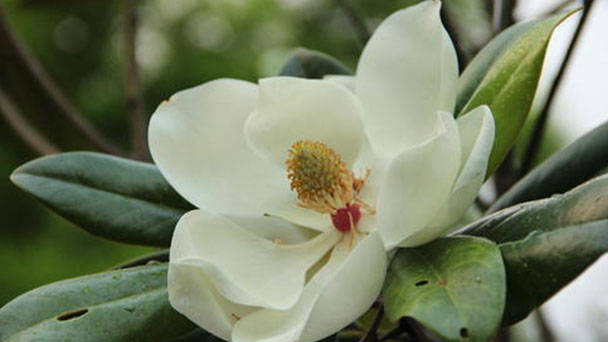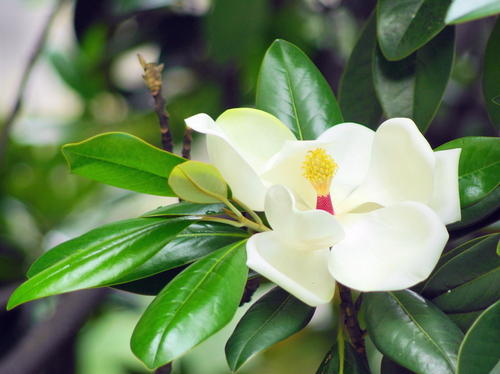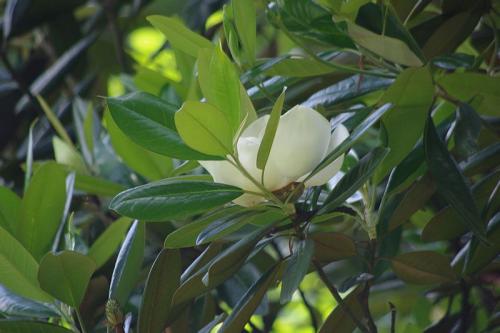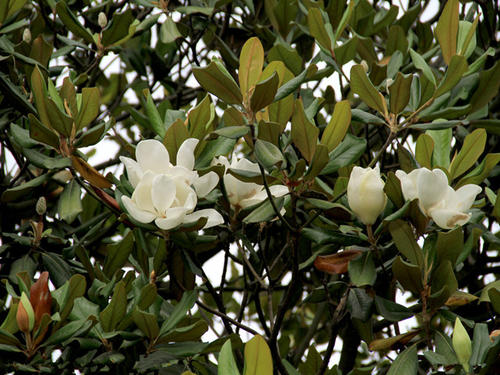Southern magnolia (Magnolia grandiflora) profile
Written by Maggie
Feb 25 2021

Southern Magnolia (Magnolia grandiflora L) : Evergreen tree, up to 30 m in its native area; Southern Magnolia bark pale is brown or gray, thinly scaly dehiscent; Branches are stout. Leaves are thickly leathery, elliptic, oblong-elliptic or ovate-elliptic, dark green, shiny. Flowers are white, aromatic, 15-20 cm in diameter; Southern Magnolia has 9-12 tepals, thickly fleshy, obovate, 6 -- 10 cm long and 5 -- 7 cm wide. Aggregated fruit terete is oblong or ovoid, follicles cleft, abaxially round, apically lateral with a long beak; Seeds of Southern Magnolia are subovoid or ovate, ca. 14 mm long, ca. 6 mm in diameter, outer coat red, seeds removed from outer coat, apical extension into a short neck.
Southern Magnolia is native to southeastern North America. It is cultivated in cities south of Yangtze River valley in China. Lanzhou and Beijing parks are also cultivated. The species is widely cultivated with over 150 cultivars. Flowers of Southern Magnolia are big, white, like lotus, fragrant, for the beautiful garden greening ornamental tree species, suitable for moist and fertile soil, sulfur dioxide, chlorine gas, hydrogen fluoride and other toxic gas resistance is strong; It is also resistant to smoke and dust. Wood yellow and white, material is strong, Southern Magnolia can be used for decoration material. Aromatic oils can be extracted from leaves, young shoots and flowers. For making flower extracts. Leaves are used in medicine to treat hypertension.
Southern Magnolia picture

Morphological characteristics of Southern Magnolia
Southern magnolia is an evergreen tree, reaching a height of 30 m in its native area; Bark is pale brown or gray, thinly scaly dehiscent; Branchlets are stout, pith heart with septum; Branchlets, buds, below leaves, petioles, all densely brown or grayish-brown tomentose (glabrous below leaves of young trees).Leaves thickly leathery, elliptic, oblong-elliptic or ovate-elliptic, 10 -- 20 cm long, 4 -- 7 (10) cm wide, apically obtuse or shortly obtuse, basally cuneate, dark green, glossy; Lateral veins 8-10 on each side; Petiole of Southern Magnolia is 1.5-4 cm long, without stipule marks, with deep furrows.
Flowers of Southern Magnolia are white, aromatic, 15-20 cm in diameter; Perianth segments 9-12, thickly fleshy, obovate, 6-10 cm long, 5-7 cm wide; Stamens ca. is 2 cm long, filaments flattened, purple, anthers introverted, septum protruding into a mucosa; Pistil group elliptic, densely tomentose; Carpel of Southern Magnolia is ovate, 1-1.5 cm long, style curled.
Aggregate fruit terete of Southern Magnolia is oblong or ovoid, 7 -- 10 cm long, 4 -- 5 cm in diameter, densely brown or grayish yellow tomentose; Follicles are fissured, abaxially round, apically lateral with a long beak; Seeds of Southern Magnolia are subovoid or ovate, ca. 14 mm long, ca. 6 mm in diameter, outer coat red, seeds removed from outer coat, apical extension into a short neck.
Ecological habits of the Southern Magnolia
Southern Magnolia likes warm and humid climate, pollution resistance, not alkali - resistant soil. The seedling stage is quite tolerant of shade. They like warm and humid climates. Harder to cold, can withstand short -19 degrees low temperature. Southern Magnolia grows well in rich, deep, moist and well drained acidic or neutral soils. Roots deep and wide, quite wind - resistant. Fewer pests and diseases. The growth rate is medium, the seedling growth is slow, the growth is gradually accelerated after 10 years.
The propagation of Southern Magnolia
Sow
In the middle of autumn, the fruits of Southern Magnolia were picked and placed in a ventilated place, and the fruits were gradually cracked, the seeds were taken out, soaked in water, the red fleshy film attached to the seed coat was rubbed off, the oil on the seed coat was washed with soda water, and then rinsed with clean water. The sand was dried and stored in the wooden box in the ventilated place, and the seeds were sown in the open field in the middle and late winter of the next year. Seedbed should be selected without diseases and pests of the new ground, with deep soil layer of yellow wood or sandy loam is appropriate, set a high bed, row drill, base fertilizer can be fully decayed human excrement and urine, dry cake, in the whole bed before turning into the soil.
We must not use garbage as a base fertilizer, so as not to bring disease, bacteria. 30 centimeters apart in order to fire, soil and loess with bran dust cover, the thickness of 3 times the diameter of the seed, the straw covering insulation moisturizing, seedling was unearthed in late spring to continuous broadcasting with crystal between the tender grass, silkworm poisoning, even four or five times, each time every 2-3, in early may can set charmilles, 40% light transmittance, mid to late autumn to dismantle, shading material available Chinese fir, bamboo curtain, etc., such as bamboo shade can peel at any time as the ideal, to choose appropriate, good drainage and young plants are generally not severe diseases and insect pests, seedling quick nitrogen topdressing 3-4 times, annual seedling 30 to 40 cm tall.You can transplant in autumn of that year.
Layering
In the case of lack of provenance and stock, the method of Southern Magnolia laying is an important means of reproduction, especially to make full use of the mother plant and give full play to the productive potential. Although the procedure is troublesome, it can solve some problems, so it has practical value. Parent with a young tree or nursery went for the best, because the collateral growth robust, strong life force, hair root easily, without affecting the tree, under the principle of choose 2 to 3 years of full thick, up for collateral, middle of spring, on the base of above 10 to 15 centimeters girdling, 3 cm long, the wound after peeling rough objects such as small Manila cambium of the peel residues on the xylem, again with plastic film cultivation soil package to the wound.
Culture soil is usually selected to keep strong water, texture by loose, not with diseases and insects is appropriate, generally take 60% yellow mud mixed rice chaff ash 40% or with vermiculite, expanded perlite, or with fully decolorized cotton seeds, textile scraps, mushroom bed soil, water content should be appropriate, with the hand when water extrusion is the degree.In order to make the wound healing fast, early root, the upper part of the wound can be coated with five thousand naphthalene acetic acid solution, slightly dry and then wrapped culture soil.
Grafting
The scion is 4-5 cm long and leaves are not left. The key points of operation are the same as that of general deciduous plants. The key to survival is that the scion should be sealed with a bud hole and wrapped up.In daily management, attention should be paid to wipe off the anvil buds at any time, and the wound binding film should not be removed in a hurry after survival. Fertilizer cultivation method, annual growth can reach more than 1 meter. In addition to cutting in early spring, bud grafting can also be used for reproduction, in autumn, the following spring cutting and pasting. Southern Magnolia is most suitable for deep soil, well drained, slightly acidic loess or sandy loam soil, in the central and Southern region is usually open cultivation.
Because Southern Magnolia developed a root group, Southern Magnolia is easy to transplant and survive. However, in order to ensure the quality of the project, no matter the seedling is large, it is necessary to take the soil ball properly when transplanting, but also because of its luxe leaves, large leaves, newly planted seedlings moisture transpiration is large, vulnerable to wind damage, so the transplanting should be immediately shearing the leaves, such as loose soil ball or ball is too small, the root system damage is heavy, should also be sparse to part of the twigs or redundant branches. Such branches are most likely to be burned by the hot sun, causing serious damage to the bark. Regardless of the large trees, young trees, newly planted trees or forest trees, if the branches are exposed to the hot sun in summer, they should be wrapped with straw rope or coated with lime emulsion as soon as possible to avoid irremediable damage. The Southern Magnolia is well-branched and well-shaped, and lets itself grow naturally without much pruning;If the purple magnolia as the rootstock of grafted seedlings, often from the root neck germination anvil bud, should pay attention to remove in time. The diseases and insect pests of Southern Magnolia are very few. In spring, attention should be paid to the prevention and control of leaf rolling moth to damage tender buds, tender leaves and flower buds. It can spray 1000 times 98% crystal tryptrite twice or three times.

Growing methods of Southern Magnolia
Season
Early spring is the best season for Southern Magnolia tree transplanting, but the plum rain season is the best. About half a month after the Spring Festival, when Southern Magnolia is still dormant, with slow SAP flow and slow metabolism, it is time to transplant. After transplantation, when the spring temperature rose in the evening, the root system first sprouted, grew and repaired. Combined with careful management, the growth of Southern Magnolia in that year would not be affected basically. In addition, in the plum rain season, the rainfall was large and the air humidity was high, so the survival rate of Southern Magnolia transplanted at this time was very high. However, it is best to pay attention to the transplantation in cloudy or cloudy weather, try to avoid heavy rain or high temperature weather.
Soil ball
The size of the earth ball is the key to the success of Southern Magnolia transplanting. In East China, the diameter of the earth ball is 8 to 10 times of the DBH of the tree, which can ensure that the root system is less damaged and the tree is easy to recover. If the soil ball is too small, the root system will be damaged seriously, which will cause difficulty in absorbing water and affect the survival of trees. The earth ball should be dug into the shape of a gyro, rather than the shape of a plate and conical, the earth ball should be tied with straw rope, so as not to loose the earth ball during transportation.
Moisture
The Southern Magnolia root is fleshy and easily loses water. Therefore, the digging, transportation and planting of Southern Magnolia root should be done quickly and in time to avoid excessive water loss and affect the survival. After Southern Magnolia is transplanted, the first root setting water should be timely and thoroughly watered, so that the root system is in full contact with the soil and the trees will survive. If there is too much rain after transplantation, drainage gutters should be opened to avoid water accumulation in the roots, resulting in the death of Southern Magnolia root rot.
Pruning
By pruning and plucking leaves, water evaporation can be reduced and water supply pressure from injured roots can be alleviated. Pruning should remove inner bore branches, overlapping branches and diseased insect branches, and strive to maintain the integrity of the tree form; Picking leaves to pick light branches of 1/3 of the amount of leaf is appropriate, otherwise it will reduce the transpiration pull, causing the root water absorption difficulties.
Maintenance
After the Southern Magnolia tree is transplanted, the tree is wrapped in a straw rope about 2 meters to reduce evaporation, and the rope can be sprayed with water to create a small humid environment during drought. After planting, support wood should be set to fix the trunk to prevent shaking and damage the root system. Piling cannot have fixed effect commonly, can choose long 3 meters to 4 meters bamboo or the tripod that other material makes is fixed. If the weather is dry after transplantation, spray on the tree canopy or high altitude spray to reduce the temperature of Southern Magnolia leaves.
The role of Southern Magnolia
Economic
Southern Magnolia flowers are big, white, like lotus, fragrant, for the beautiful garden greening ornamental tree species, suitable for moist and fertile soil, sulfur dioxide, chlorine gas, hydrogen fluoride and other toxic gas resistance is strong; Southern Magnolia is also resistant to smoke and dust. Wood yellow and white, material is strong, and Southern Magnolia can be used for decoration material. Aromatic oils can be extracted from leaves, young shoots and flowers. For making flower extracts.Leaves are used in medicine to treat hypertension.Seed oil, oil content of 42.5%.
The botanical garden
Southern Magnolia can be used as a garden, street tree, or court shade tree. The Southern Magnolia trees are magnificent in appearance, with large leaves and thick shade, and the flowers are lotus-like and fragrant.It is a beautiful ornamental tree for landscaping. It is advisable to plant Southern Magnolia alone, in clusters or in rows. Southern Magnolia is also resistant to smoke and wind, and has strong resistance to toxic gases such as sulfur dioxide, so it is also a good tree for air purification and environmental protection.

Latest Updated
- Benefits of Bugleweed - 7 Science-backed Health Benefits
- Bugleweed Dangers & Side Effects - Is It Poisonous?
- How to Plant Evergreen Trees - What You Should Know
- When to Plant Evergreens - Grow Guide for Evergreen Trees
- 12 Wonderful Evergreen Shrubs for Your Garden
- 12 Popular Evergreen Plants with Pictures for Beginners
- When And How To Prune A Lilac Bush Like a Pro
- How to Grow & Care for Lilac Vine (Hardenbergia Violacea)
- Japanese Lilac Tree (Syringa Reticulata) Care & Propagation Guide
- Shumard Oak Pros and Cons - What to Know
Popular Articles
- Winter maintenance of Antirrhinum Majus
- How to Grow Terminalia Mantaly Tree
- How to Grow and Care for Crossostephium Chinense
- How to grow Antirrhinum Majus in spring
- Peristeria Elata (Dove Orchid) Profile: Info & Care Guide
- Underwatered Snake Plant (Sansevieria Trifasciata) - Signs And How To Fix
- How to Care for Brazilian Jasmine Plant (Mandevilla Sanderi)
- How to Grow & Care for Graptopetalum Purple Delight in Summer
- Rosa Chinensis (China Rose): Plant Growing & Care Tips
- How to Care for Baby Sun Rose (Aptenia Cordifolia)